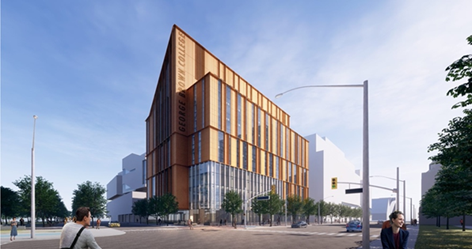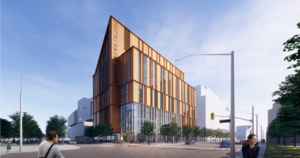Carpenters key to a changing landscape in sustainable building
The Toronto skyline is rapidly changing. Mass timber structures are springing up among the concrete and steel jungle. The newest addition to Toronto’s waterfront is underway at George Brown College, the site of Ontario’s tallest mass timber structure.
Toronto’s Moriyama & Teshima Architects designed the 10-storey structure, called Limberlost Place, along with Acton Ostry, the architects of Tallwood House at the University of British Columbia, the tallest mass timber structure in Canada.
The eco-friendly design, is one of the latest examples of innovation and sustainable development. Once completed, the building, located on the corner of Queens Quay East and Lower Sherbourne St, will be capable of capturing green energy from its surrounding environment through the use of solar chimneys, rooftop solar panels and deep-water cooling systems.
The structure will include over 15,500 cubic metres of sustainably harvested wood products capable of storing just over 12,700 metric tonnes of carbon dioxide. The environmentally sustainable design is part of a greater movement to help fight climate change and achieve net-zero emissions.
When complete, the building will be capable of generating the same energy it uses. In terms of carbon and energy savings, the more than 4,900 metric tonnes of carbon dioxide avoided in greenhouse gas emissions translates to removing 3,740 cars from the road for one year.
The construction industry is at the forefront of technology. Mass timber is just one example of the industry’s constant innovation of building materials and methods in a changing world. The College of Carpenters and Allied Trades (CCAT) is a key player in training the next generation of carpenters in the fundamentals of mass timber construction at their facility in Woodbridge, Ontario.
Currently, CCAT is the only institution in Canada offering a four-week course that teaches students the skills to necessary to construct mass timber structures. Mike Yorke, President of the Carpenters’ District Council of Ontario told the Corriere, “carpenters are setting standards and the benchmark high in terms of training for new evolutionary development in construction”.
As the city scape continues to evolve, mass timber projects are part of that evolutionary change. “The public sector is leading the way”, Mr. Yorke commented. Other projects well underway include Centennial College’s Progress Campus in Scarborough, the city’s first educational institution to start erecting the mass timber structure earlier this Fall. Another three-story mass timber project is currently under construction; it will house the Ontario Secondary School Teachers Federation Headquarters.
The use of wood products like mass timber, (strips of wood laminated together to form strong structural building components) in construction, provide a durable alternative to conventional materials like concreate and steel. Furthermore, mass timber projects generally produce less waste, less pollution, help minimize greenhouse gas emissions and render a more esthetically pleasing structure.
Not only is the raw material a natural renewable resource found in forests covering 40% of Canada’s land mass, the process of forest management and wood manufacturing help support resource-based communities by creating job opportunities and drive economic growth.
Photo credit: Limberlost Place, George Brown College. Image courtesy Moriyama & Teshima Architects and Acton Ostry




